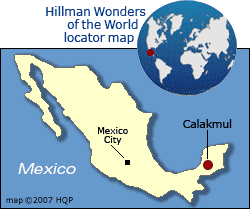Calakmul
 Why
Calakmul
is special
Why
Calakmul
is specialCalakmul was one of the largest, greatest and most sophisticated Mayan cities, yet was not discovered by modern man until about 75 years ago.
Calakmul tips and insights
How to pronounce
Calakmul: kah_lock_MOOL
Peak period
This city-state was at its peak from about 500 to 850 AD. It likely had a population of 50,000.
Calakmul's grandest pyramid
It is named Structure II (see photo above). This construction is as high as a modern 16-story building. You can climb to the top for a breathtaking view of the surrounding jungle stretching to the horizon. However, the stone steps are steep and have short treads.
Not for every tourist
I would hesitantly recommend Calakmul to anyone without at least a basic knowledge of Mayan history and archaeology.
-
Not a sightseer's paradise
Unlike in popular Mayan sites like Tikal, Palenque and Chichen Itza, you and your camera see little of the ruins as you walk around because much of the jungle growth has yet to be trimmed back.
- There is no airport
You have to take a four-hour ride over so-so roads from Campeche, the nearest city.
Calakmul was discovered during an aerial survey in 1931 - and excavation did not commence until 1985. Today, much remains uncovered.
Informative stelae
Archaeologists learned a lot about Calakmul's ancient history by deciphering upright engraved stones (stelae), such as the one in the photo on page one.
Biological reserve
This archaeological site lies inside a vast biological reserve established to protect jaguars and other endangered species.
Map Location



